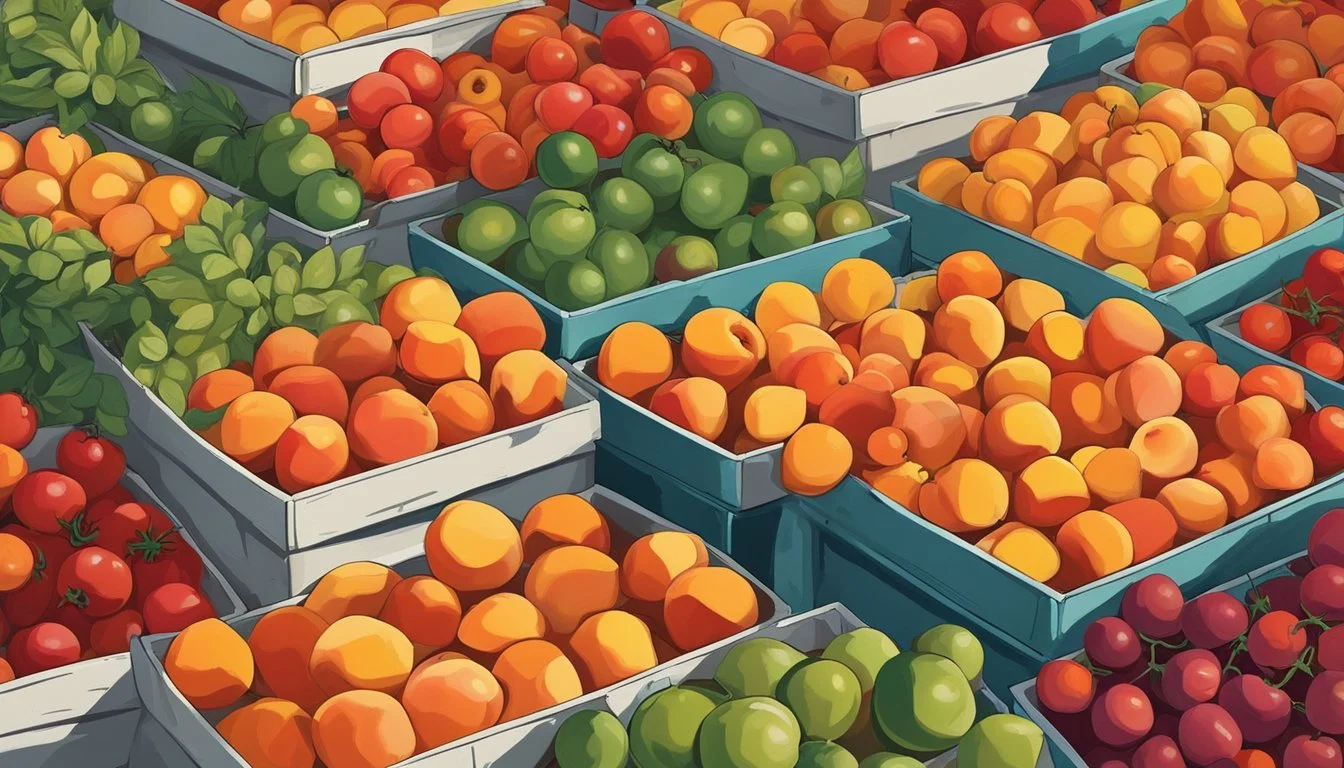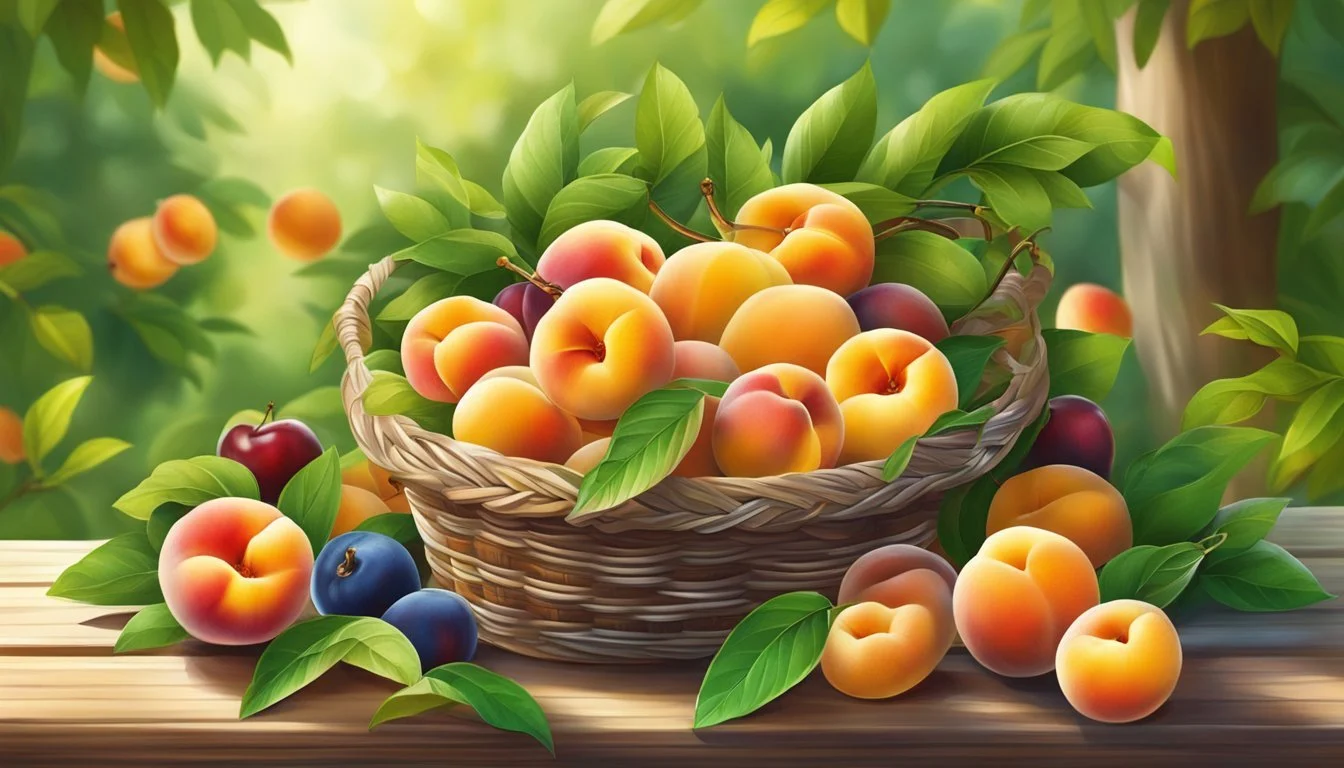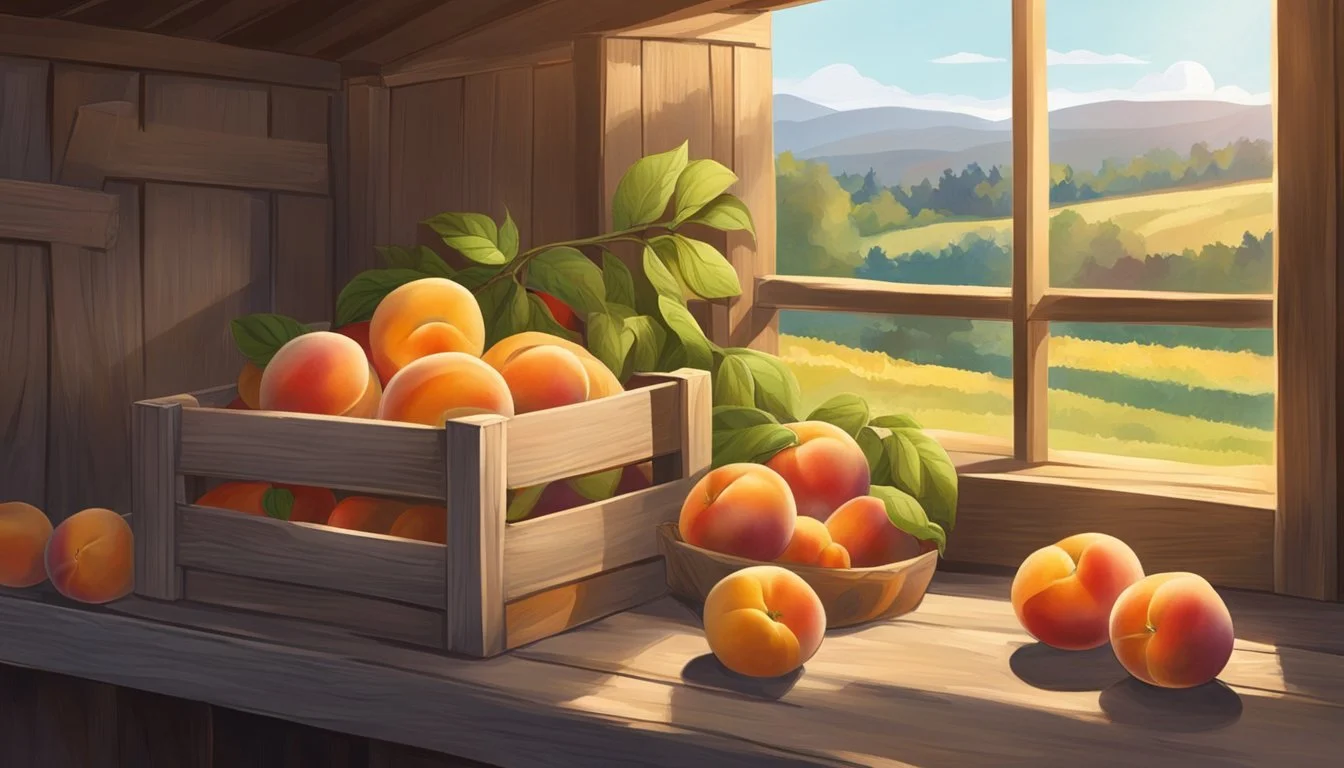Utah Seasonal Fruit & Vegetables in July
Your Guide to Fresh Produce
This Article is Part of our Utah Seasonal Fruit & Veg Calendar
July in Utah offers a vibrant palette of fresh fruits (What wine goes well with fruit?) and vegetables, thanks to the state's diverse climate and fertile soils. This period marks a time of abundance where farmers' markets and grocery stores are filled with the freshest seasonal produce. Utah's agricultural sector takes pride in cultivating a variety of crops that reach their peak during this mid-summer month.
Seasonal produce not only provides the highest quality and flavor but also supports local farming communities. In July, Utahns look forward to a rich selection of fruits including cherries (how long do cherries last?), known for their juicy sweetness, and cantaloupes (how long does cantaloupe last?) entering their prime harvest season. Vegetables such as carrots, zucchini, and cucumbers (how long do cucumbers last?) also make their way into the local diet, offering crisp textures and fresh flavors to a plethora of dishes.
Furthermore, leafy greens like chard thrive in the July warmth, alongside cruciferous favorites such as cauliflower. These seasonal offerings are not just culinary staples for locals; they mirror Utah's commitment to sustainable agriculture and community health. Consumers are encouraged to partake in this monthly harvest, which demonstrates the state's unique capability to produce a broad range of fresh, nutritious produce during the height of summer.
Summer Season Overview
July marks the height of summer in Utah, reflecting a vibrant growing season, with long days and typically warm temperatures that facilitate the cultivation and harvest of a diverse array of fruits and vegetables.
Understanding Seasonality
Summer in Utah showcases a bountiful yield of produce, as seasonality plays a critical role in determining the availability of fresh fruits and vegetables. During the summer months, farmers' markets and grocery stores are stocked with local produce at its peak of freshness and nutritional value. For instance, July sees a variety of produce such as beets, broccoli (how long does broccoli last?), carrots, and cucumbers.
Climate Impact on Produce
The warm temperatures of a Utah summer significantly influence the quality and growth patterns of produce. With its semi-arid climate, the state experiences hot summers, which can vary significantly in temperature and precipitation throughout its regions, affecting the growing season. These conditions are conducive to growing certain types of produce that thrive in warm weather, ensuring that fruits such as blackberries and vegetables such as cauliflower are available and abundant during this time.
Fruits in Season
The month of July in Utah is bountiful for fruit harvests, with a variety of stone fruits, berries, and melons reaching their peak ripeness and flavor.
Stone Fruits
Utah's stone fruit selection in July includes a succulent range of peaches, nectarines, apricots, and plums. These fruits are known for their firm yet juicy flesh and are favorites for fresh eating, baking, and preserves.
Peaches: Varieties such as Suncrest, Red Haven, and Summerlady are typically abundant.
Nectarines: Similar to peaches but with smooth skin, they offer a slightly different taste experience.
Apricots: Often harvested in early July, their soft and sweet profile is ideal for desserts.
Plums: With a range of flavors from sweet to tart, plums are versatile in the kitchen.
Berries Variety
Berries are a true highlight of July's fruit offerings in Utah. Freshly picked raspberries, blackberries, and blueberries (how long do blueberries last?) are readily available, each with their distinct sweet-tart flavor profiles perfect for snacking or adding to summer dishes.
Raspberries: Ripe for the picking and bursting with flavor.
Blackberries: Juicy and nutrient-rich, ideal for adding to yogurt or baking.
Blueberries (limited to June and July): Though their season is short, they are a highly anticipated treat.
Melons
The warm July weather ushers in the season for a variety of melons, featuring watermelons which are a hydrating favorite during summer festivities.
Watermelons: Cultivated for their cool, crisp flesh and enjoyed as a sweet, refreshing snack.
Other melons such as cantaloupes also start to make their appearance, with their peak season starting in mid-August. However, early varieties might be available at local markets.
By focusing on these fruits that are in season, consumers can enjoy the freshest produce, support local agriculture, and potentially reduce their carbon footprint due to reduced transportation of out-of-season imports.
Vegetables in Season
The wealth of the Utah soil in July is evident through its vibrant variety of vegetables that reach their peak. The warm temperatures and long daylight hours contribute to the growth of a diverse range of vegetables, each with their distinct flavors and health benefits.
Leafy Greens
In July, leafy greens like kale and chard are in abundance. These vegetables are not only versatile in cooking but also packed with essential vitamins and minerals. Shoppers can find fresh bunches at local markets, perfect for salads and sautés.
Kale: Rich in vitamins A, K, and C.
Chard: Offers a great source of magnesium and iron.
Root Vegetables
The root vegetables like beets, carrots, and potatoes also come into season, offering earthy flavors and nutritional value. They are ideal for roasting or boiling and can be a central part of a hearty meal.
Beets: Known for their deep red color and sweetness.
Carrots: Crunchy and packed with beta-carotene.
Potatoes: A staple with a wide range of culinary uses.
Nightshades
Tomatoes and eggplant (how long does eggplant last?) are among the popular nightshades that thrive in July's warmth. Peppers also join the group, ranging from sweet to hot, suitable for a variety of dishes.
Tomatoes: Juicy and rich in lycopene.
Eggplant: Versatile for many cooking methods.
Peppers: Available in various levels of heat.
Pod Vegetables
July marks a significant period for pod vegetables like green beans and peas. They are at their tenderest and most flavorful stage. Quick cooking methods like steaming can maintain their crisp texture and bright color.
Green Beans: Best when slender and firm.
Peas: Sweet, especially when freshly picked.
Harvesting and Storage Tips
Harvesting fruits and vegetables at the right time is crucial to ensure the best flavor and longevity. Proper techniques can greatly influence how fresh produce remains post-harvest. Different storage methods are essential to maintain freshness for as long as possible.
Proper Harvesting Techniques
One should harvest vegetables early in the morning when they are most hydrated. For fruits like tomatoes and peppers, wait until they are fully colored and easily come off the stem. Leafy greens should be cut at the base and handled gently to avoid bruising.
Fruits:
Tomatoes: Wait for full color and ease off the stem.
Peppers: Look for full size and a deep, consistent color before picking.
Vegetables:
Leafy greens: Harvest early morning; cut at the base.
Root vegetables: Check for size; loosen soil with a fork before pulling up.
Storage for Longer Freshness
Store fruits and vegetables in a cool, dry place or refrigerate them to extend their shelf life. Tomatoes are best kept at room temperature away from direct sunlight to maintain their flavor. Leafy greens require moisture and should be stored in the refrigerator in a container or plastic bag with a damp cloth to stay fresh.
Room Temperature:
Tomatoes: Best kept at room temperature, away from sunlight.
Refrigeration:
Leafy Greens: In a sealed container or plastic bag with a damp cloth.
Root Vegetables: In a cool, dark place or a refrigerator drawer.
By adhering to these harvesting and storage guidelines, one can enjoy the flavorful bounty of Utah's seasonal produce well beyond the harvest.
Preparing Seasonal Dishes
July in Utah brings an abundance of fresh produce, leading to a myriad of dishes where fruits and vegetables can shine. From vibrant salads to sweet preserves, the season’s offerings are versatile enough to be incorporated into any meal.
Salads and Entrées
Utilizing fresh vegetables, such as beets and carrots, can elevate the nutritional value and flavor profile of salads and entrées. These vegetables can easily be roasted to bring out their natural sweetness and added to a summer salad. For example:
Roasted Beet Salad: Beets roasted until tender, mixed with greens, and garnished with goat cheese and walnuts (how long do walnuts last?).
Carrot Salsa: Fresh carrots finely diced and combined with herbs and citrus to create a vibrant salsa, perfect as a topping for grilled dishes (What wine goes well with grilled dishes?).
Preserving the Harvest
Preservation techniques enable the enjoyment of July produce long after the season ends. Making jam or pickles from ripe berries and vegetables ensures these flavors can be enjoyed year-round. Dishes that highlight this include:
Blueberry Jam: Fresh blueberries simmered down with sugar to create a flavorful spread for morning toast or desserts.
Pickled Carrots: Thinly sliced carrots brined in a mix of vinegar, sugar, and spices, an excellent addition to sandwiches or as a snack.
Desserts and Sweets
Desserts featuring July’s fruit complement the season's bounty with natural sweetness and offer a refreshing end to any meal. In Utah, fruit-based desserts (\What wine goes well with fruit-based desserts?) hold a place of honor on the table. Examples include:
Apricot Crisp: Ripe apricots topped with an oat crumble, baked until golden and bubbly.
Berry Butter: Berries blended into a smooth butter, perfect for spreading on fresh baked goods.
Shopping for Seasonal Produce
In July, shoppers have the opportunity to enjoy a variety of fresh and plump fruits and vegetables at local farmers markets throughout the state of Utah. It's the perfect time to take advantage of summer's plentiful harvest.
Farmers Markets
Farmers markets in Utah are bustling with activity in July as they offer a diverse array of locally grown produce. Shoppers should look for markets that source directly from local growers, ensuring they are purchasing the freshest seasonal items available. One can find markets spread across the state, from Salt Lake City to St. George, each providing a snapshot of the region's produce bounty. At these markets, one can expect to find:
Vegetables: Fresh beets, crisp broccoli, and various types of greens.
Fruits: Ripe blackberries, juicy blueberries, and sweet cantaloupes.
It is advisable to visit the markets early for the best selection and to beat the heat of the Utah summer.
Selecting Quality Produce
When shopping for seasonal produce in Utah's farmers markets, here's how to identify the fresh and high-quality picks:
Vegetables: Choose beets that are firm and have a vibrant color. Select broccoli with tight, dark green florets.
Fruits: Look for blackberries that are deep in color and not leaking. Blueberries should be plump and uniform in size, while cantaloupes should have a fragrant aroma and a rind that yields slightly to pressure.
Remember that fresh summer produce not only tastes better but often comes with a higher nutritional content, making it a healthy choice for the season.
Health and Nutrition
In Utah during July, a variety of fresh fruits and vegetables are available which are packed with nutritional value. These seasonal picks are not just full of flavor but also provide numerous health benefits.
Fruits such as peaches, melons, and sweet cherries are rich in vitamins, minerals, and antioxidants. They aid in hydration due to their high water content, which is particularly beneficial during the dry Utah summer months. The following list outlines some key nutrients found in these fruits:
Peaches: High in Vitamin C, potassium, and dietary fiber.
Melons: Offer Vitamin A, Vitamin C, and are a low-calorie hydrating fruit.
Sweet Cherries: A good source of antioxidants and anti-inflammatory compounds.
Similarly, vegetables like tomatoes, beans, beets, and cucumbers are available in abundance. These vegetables are essential for a well-balanced diet, offering a range of health benefits, including the promotion of digestive health due to their dietary fiber content. Here's a snapshot of what they offer nutritionally:
Tomatoes: Contain lycopene, Vitamin C, and potassium.
Beans: Provide plant-based protein, iron, and complex carbohydrates.
Beets: Rich in folate, fiber, and nitrates which are good for blood pressure.
Cucumbers: High water content and a source of Vitamin K.
Eating seasonally ensures individuals are getting foods at their peak for flavor and nutrition, which can enhance a healthy lifestyle. Integrating these food items into the diet supports various aspects of health, from boosting the immune system to maintaining a healthy weight. Consumers can be confident in the nutritious advantages of incorporating these seasonal fruits and vegetables into their meals.








